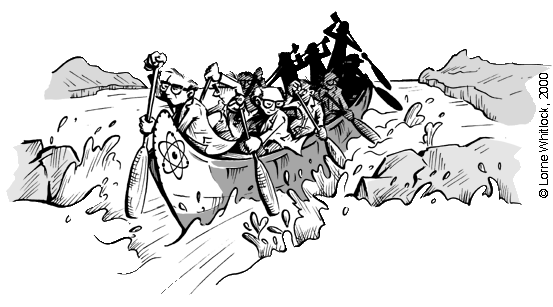|
Published in the April 2016
issue of the Canadian
Nuclear Society Bulletin, Vol.37, No.1.
What a Canoe Teaches Us
by Jeremy Whitlock
Some wag once said that canoes are the closest humans have come to creating a perfect machine. Whether or not this notion holds water, the craft's historical consequence - without it, there would be no Canada (at least as we know it) - is without question. Less appreciated is the canoe's legacy to engineering design: it is a birch bark cornucopia of best practices, evolved from centuries of in-field, and largely indigenous, application.
Consider the following lessons in "good technology design", taught to us by our venerable deckless, keelless bateau:
- Minimization of moving parts: The canoe has none. Or more correctly, it has one - the human driving it. The human is, after all, very much part of the machine: it is the motive force, the adjustable ballast, most of the mass, the steering mechanism, the guidance and stability feedback system, and the integral fuel tank. The canoe typically can go five km on one granola bar.
- Minimization of environmental footprint: The craft itself leaves behind no impression of itself, adding nothing to the water or air, and only a mark in the sand that disappears with the next rain storm. It is silent, emission free, low in profile, and thus invites the operator to become an integral part of the world he or she is observing.
- Leveraging simplicity: A paragon of efficiency, the canoe can transport many times its own weight while drawing inches of water (the leader in this category is the 7-metre canot de maître of the Voyageurs - supporting 5 tonnes of men and cargo while weighing 140 kg empty.) Sturdy enough to carry people and freight by water, but light enough to be carried between waterways - the perfect craft for the Canadian Shield country.
- Incorporating cultural wisdom: The European explorers and fur traders quickly dispensed with any technology they brought with them for travelling the waterways of the New World - and adopted the technology of the indigenous peoples. Learn from those that have walked the path before, listen to elders, park egos.
- Passive safety: More of a contemporary design modification, canoes today typically include built-in bow and stern flotation that, while doing nothing to prevent ejection of occupants in the middle of a set of rapids, will raise the probability that the canoe (and the ultimate transportation out of the bush) makes it to the end of the rapids in one piece, even filled with water.
- Operational flexibility: There is no correct way to paddle a canoe, only preferences. There is also neither a front nor back of the craft; its profile is symmetric. Solo paddlers typically face the opposite end that a pair of paddlers face, for reasons of optimal weight distribution. When needed, the canoe can serve as shelter - keeping the rain off during a portage, or even to sleep under (a common practice for Voyageurs).

- Available supply chain: Whether cedar, birch bark or dugout, traditional canoes were manufactured from the materials found along the routes they were paddled, enabling speedy repair. Modern paddlers tend to substitute duct tape and fiberglass kits for spruce gum and roots - a little less elegant but somewhat more reliable.
- Ergonomic interface: A canoe can be operated using a variety of body positions and paddle strokes, allowing not only adjustment to changing wind and water conditions, but periodic relief of muscles. If needed one can even stretch out and catch a nap. (As the late Pierre Berton pointed out, a true Canadian is capable of more than that, should the right partner come along.)
- Synthesis of needs: The most abstract, and arguably most seductive, of the canoe's qualities: in one structure the craft combines the aggressive, exploratory, risk-taking, notionally masculine trait of the adventurer thrusting into the unknown, with the nurturing, protective, emotive, notionally feminine trait of the provider living sustainably with nature. The keen paddler, however incognizant of this metaphysical connection, likely senses its allure every time he or she crosses the gunwales.
Technologies come and go - yet despite vast improvements in materials and manufacturing (not to mention transportation alternatives), the canoe has thrived with essentially the same form and function for thousands of years.
Co-opting this technology from indigenous teachers was a wise choice for early colonials. Systematically disenfranchising the technology's inventors for centuries to follow, however, was a colossal failure of techno-social progress - only now beginning to be recognized. This is the final and perhaps most important lesson of the canoe.
|